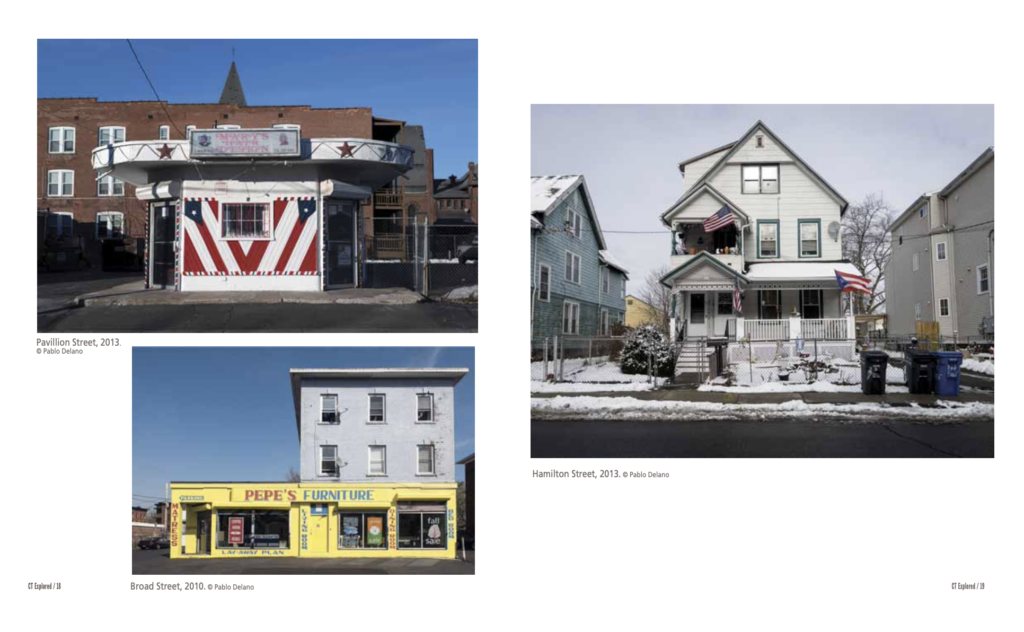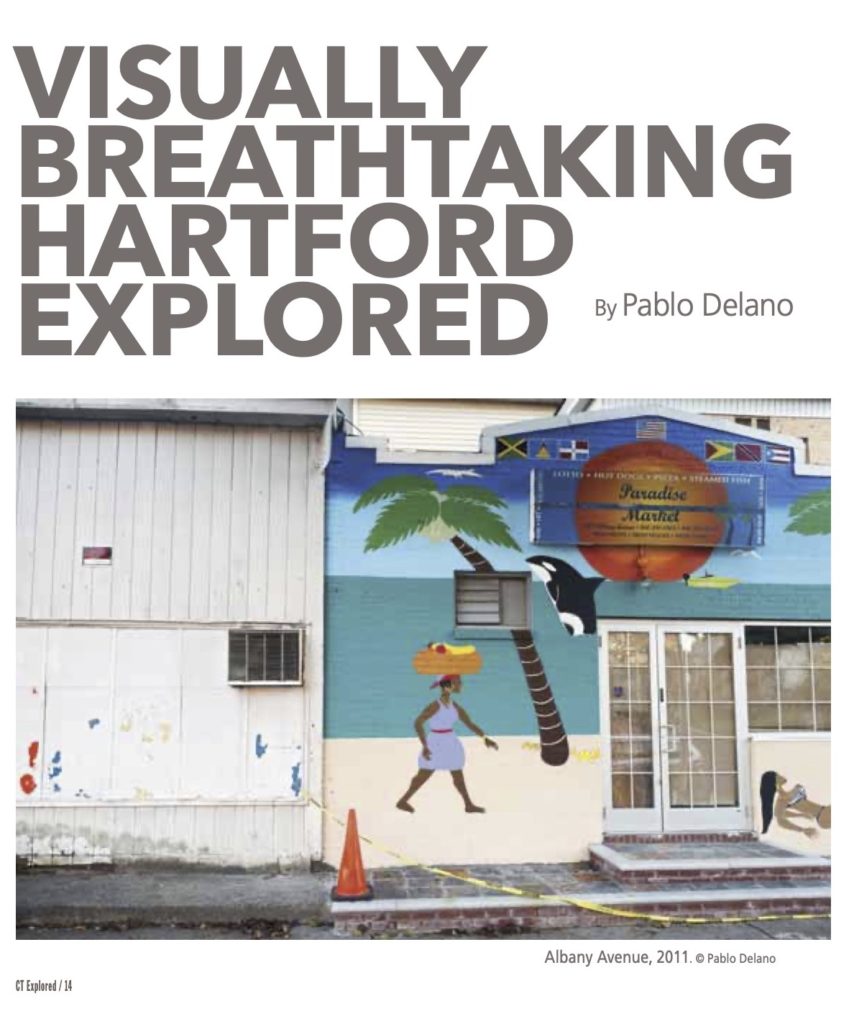By Pablo Delano
(c) Connecticut Explored Inc. Summer 2021
Subscribe/Buy the Issue!
All images © Pablo Delano
Even before moving to the area in 1996 to start my new job at Trinity College, I had heard all of the warnings. Hartford, once the insurance capital of the world and one of the country’s most prosperous cities in the 19th century, was said to have degenerated into one of its poorest. There was little of interest beyond the historical landmarks of its Yankee past. Major highways ran through the city—making for an easy escape to the cultural meccas of New York and Boston. Even real-estate agents eager to sell me a house told me as much: “The good thing about Hartford is how easy it is to leave.” In short, Hartford was supposedly dull, dangerous, and hopeless. But my gut didn’t buy it.
Hartford bears the scars, and reaps the benefits, of the urban renewal and social upheaval of mid-20th century America. Its population of 120,000 (pre-, and presumably post-, COVID) nearly doubles each day, thanks to suburbanites commuting to their white-collar jobs. Sundown provokes a corresponding exodus. Hartford today is a so-called majority-minority city, with a longstanding African-American population and a Puerto Rican presence that blossomed during the 1950s and 1960s as many left the island to work in Connecticut’s tobacco fields. [See “Tobacco Valley: Puerto Rican Farm Workers in Connecticut,” Fall 2002.]
This appealed to me as an interesting phenomenon to explore photographically.
For a small city, Hartford boasts extraordinary ethnic diversity and fluidity. Park Street may be the hub of Hispanic commerce, but you will find Vietnamese, Chinese, Lao, Brazilian, and Portuguese businesses next to the Dominican, Mexican, and Peruvian restaurants, barbershops, markets, and places of worship. Along Albany Avenue, West Indian and African-American establishments predominate. This cultural diversity resonates in the built environment, which is continually adapted and repurposed to suit the needs and tastes of the newer populations.
Hardly dull, I thought. Visually, breathtaking. The grays, muted ochres, and brick reds of old New England succumb to a vibrant Caribbean palette of neon greens, acid oranges, and piercing yellows. A front porch becomes a nail salon, a storefront becomes an auto repair shop. In the North End, virtually every former synagogue remains a focus of spiritual life, only now the buildings—still bearing Hebrew lettering and stars of David—are used as churches: the worshipers are Adventists, Baptists, and Pentecosts.

clockwise from top left: Pavillion Street, 2013, Hamilton Street, 2020 (correction), Broad Street, 2010. (c) Pablo Delano
I quickly realized that negative stereotypes about the city were misinformed at best. I felt an immediate familiarity and affinity for Hartford; a kinship with its texture, energy, and rhythm. It reminded me of other cities I connected with, such as my native San Juan, Puerto Rico, or Port-of-Spain, Trinidad; cities that struggle with, yet manage to mitigate, a legacy of colonial domination thanks to the ingenuity, resourcefulness, and determination of their citizens.
Hartford’s built environment manifests this creative spirit. It tells a story of a brash new beauty but also of respect for historical form. Layers of brick, paint, and plaster reveal the city’s layers of history. The buildings whisper to me every day, as I drive or walk the streets, about the complex human dramas they have witnessed—fascinating stories for those willing to open their eyes and ears. Without immediately realizing it, I set about to make pictures that gave the buildings a voice.
Could photographs refute dismissive and disparaging attitudes about the city? I did not consider this question when I started photographing Hartford. It was a private matter, an intuitive response to my surroundings. Yet I was not unfamiliar with the idea of documenting. The great enterprise of the Farm Security Administration is embedded in my consciousness because of the work my father, Jack Delano, contributed to that photographic legacy, as David Gonzalez eloquently documents (“Jack Delano’s American Sonata,” The New York Times, October 13, 2011.) As children, my sister and I would share with our classmates an old stack of vintage F.S.A. prints by Walker Evans, Dorothea Lange, Arthur Rothstein, and others that we’d bring from home.
If there is a similarity between my Hartford photographs and F.S.A. work from the 1930s or 1940s, it is not a result of nostalgic or conscious emulation. It may have resulted from shared concerns about subject, concerns as valid today as they were then. I wish to portray Hartford as a city with dignity, and the F.S.A. photographers approached their subjects with respect. As I immersed myself in the project I also studied a broad range of urban photography, including work by Eugène Atget, Charles Sheeler, Berenice Abbott, and Lee Friedlander.
An exhibition of 126 of my Hartford photos was on view at the Connecticut Historical Society in 2014 and at the Hartford Public Library’s Art Walk Gallery in 2017. My book Hartford Seen was published in 2020 by Wesleyan University Press, with 151 color photographs. Some observers questioned the absence of images depicting many of Hartford’s best-known landmarks, but for the most part the response has been humbling. At the historical society exhibition opening, an older woman thanked me repeatedly, proclaiming, “I’m in tears—Hartford bred and born,” then led me to a photo of an apartment building her father built when she was a little girl. “He loved those gargoyles,” she told me.
With the launch of the book, I thought the project was complete. But new details reveal themselves continually, like those gargoyles, and the city continues to evolve and adapt, dramatically so in the era of COVID-19. All along, the automobile has been important, from the Columbia Motor Car Company of 1908 to the thousands of cars that make the journey from suburbs to city and back each workday. For Hartford’s citizens and suburbanites alike, the car window becomes a frame of reference. So, late in 2020, I began a personal photographic diary of sorts, documenting my movements through the city from the perspective of the road. My earlier work depended upon bulky, high-resolution cameras, but now I chose to photograph with my phone. The process has become part of my daily routine.
Safe from the raging pandemic, I feel like I see the city afresh every day from inside my little glass box on wheels.
See more images in the print issue. Get it for free with our First One Free Offer.
Pablo Delano is a visual artist and photographer, professor of fine arts at Trinity College, and author of Hartford Seen (Wesleyan University Press, 2020). Visit PabloDelano.com.
GO TO THE NEXT STORY Go back to Summer 2021 Contents
Explore!
“Jack Delano’s FSA Images of Connecticut and Puerto Rico”
Grating the Nutmeg Episode 123: Connecticut Seen: The Photography of Pablo Delano and Jack Delano
Subscribe/Buy the Print Issue
Sign up for our bi-weekly e-newsletter

